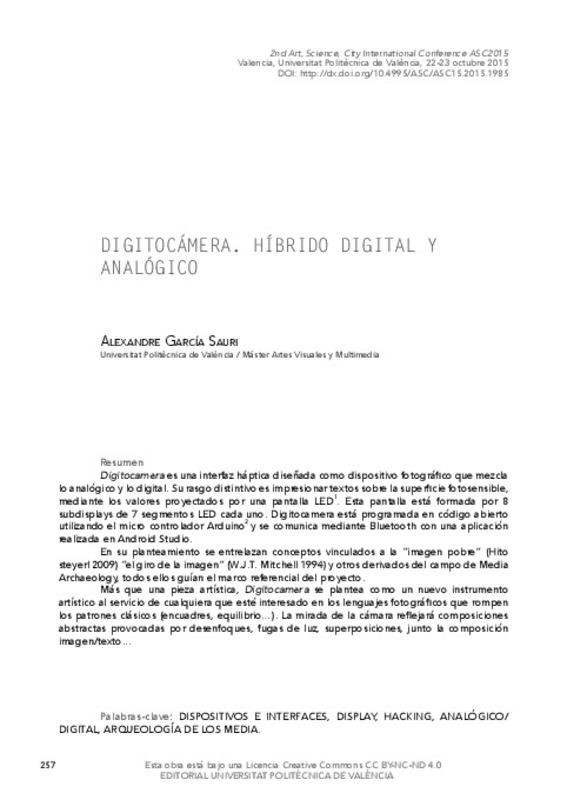JavaScript is disabled for your browser. Some features of this site may not work without it.
Buscar en RiuNet
Listar
Mi cuenta
Estadísticas
Ayuda RiuNet
Admin. UPV
DIGITOCAMERA. HÍBRIDO DIGITAL Y ANALÓGICO
Mostrar el registro sencillo del ítem
Ficheros en el ítem
| dc.contributor.author | García Saurí, Alexandre
|
es_ES |
| dc.date.accessioned | 2018-01-31T13:09:26Z | |
| dc.date.available | 2018-01-31T13:09:26Z | |
| dc.date.issued | 2015-11-17 | |
| dc.identifier.isbn | 9788490484562 | |
| dc.identifier.uri | http://hdl.handle.net/10251/96318 | |
| dc.description.abstract | [EN] Digitocamera is an haptic interface designed as a photographic device which mixes the analogue and the digital. Its distinctive feature is to leave an impression of texts over the photosensitive surface, by the values that a LED screen sends. This screen is form by 8 subdisplays of 7 segments of LED, each. Digitocamera is programmed in open-source using the microcontroller Arduino and controlled via Bluetooth with an application made with Android Studio. In the project approach are intertwined concepts linked to the “poor image” (Hito Steyerl) “picture turn” (WJT Mitchell) and other derivatives of Media Archaeology field, all of them are guiding the reference framework of the project . More than artistic piece, Digitocamera is contemplated as a new artistic tool at the service of anyone interested in the photographic visual languages linked to breaking the classic rules (framing, balance...) The glance of the camera tends to abstracts compositions caused by lack of focus, light leaks, superposition. | es_ES |
| dc.description.abstract | [ES] Digitocamera es una interfaz háptica diseñada como dispositivo fotográfico que mezcla lo analógico y lo digital. Su rasgo distintivo es impresionar textos sobre la superficie fotosensible, mediante los valores proyectados por una pantalla LED1 . Esta pantalla está formada por 8 subdisplays de 7 segmentos LED cada uno. Digitocamera está programada en código abierto utilizando el micro controlador Arduino2 y se comunica mediante Bluetooth con una aplicación realizada en Android Studio. En su planteamiento se entrelazan conceptos vinculados a la “imagen pobre” (Hito steyerl 2009) “el giro de la imagen” (W.J.T. Mitchell 1994) y otros derivados del campo de Media Archaeology, todos ellos guían el marco referencial del proyecto. Más que una pieza artística, Digitocamera se plantea como un nuevo instrumento artístico al servicio de cualquiera que esté interesado en los lenguajes fotográficos que rompen los patrones clásicos (encuadres, equilibrio…). La mirada de la cámara reflejará composiciones abstractas provocadas por desenfoques, fugas de luz, superposiciones, junto la composición imagen/texto... | es_ES |
| dc.format.extent | 5 | es_ES |
| dc.language | Español | es_ES |
| dc.publisher | Editorial Universitat Politècnica de València | es_ES |
| dc.relation.ispartof | Actas Segundo Congreso Internacional Arte Ciencia Ciudad ACC2015 | es_ES |
| dc.rights | Reconocimiento - No comercial - Sin obra derivada (by-nc-nd) | es_ES |
| dc.subject | Dispositivos e Interfaces | es_ES |
| dc.subject | Display | es_ES |
| dc.subject | Hacking | es_ES |
| dc.subject | Analógico/Digital | es_ES |
| dc.subject | Arqueología de los media | es_ES |
| dc.title | DIGITOCAMERA. HÍBRIDO DIGITAL Y ANALÓGICO | es_ES |
| dc.type | Capítulo de libro | es_ES |
| dc.type | Comunicación en congreso | es_ES |
| dc.rights.accessRights | Abierto | es_ES |
| dc.description.bibliographicCitation | García Saurí, A. (2015). DIGITOCAMERA. HÍBRIDO DIGITAL Y ANALÓGICO. En Actas Segundo Congreso Internacional Arte Ciencia Ciudad ACC2015. Editorial Universitat Politècnica de València. 257-261. http://hdl.handle.net/10251/96318 | es_ES |
| dc.description.accrualMethod | OCS | es_ES |
| dc.relation.conferencename | 2º Congreso Internacional ACC: Arte, Ciencia, Ciudad | es_ES |
| dc.relation.conferencedate | October 22-23,2015 | es_ES |
| dc.relation.conferenceplace | Valencia, Spain | es_ES |
| dc.relation.publisherversion | http://ocs.editorial.upv.es/index.php/ASC/ASC15/paper/view/2048 | es_ES |
| dc.description.upvformatpinicio | 257 | es_ES |
| dc.description.upvformatpfin | 261 | es_ES |
| dc.type.version | info:eu-repo/semantics/publishedVersion | es_ES |
| dc.relation.pasarela | OCS\2048 | es_ES |






